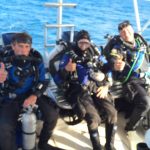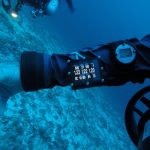Mission Day: Four, Five and Six
 |
| The SVS Camera System with the light brackets… minus the lights. |
 |
| Todd Holding the SVS Camera System Susan, reeling in the transect tape behind Me? On the other side of the camera |
As you know, we custom built the SVS camera mount for the scooters and within 2 minutes, we started shucking ballast tubes, lights, video mount (yes the one we custom built) because it did not work. We simply grabbed the camera and Todd, who was camera man, held the camera in his hands and swam the two 50 meter transects and was highly successful. The most important outcome of this dive was that we gathered tremendous intel and knowledge to pass on to our other dive team that would allow them to improve upon our dive. We accomplished 3 SVS video transects and 2 benthic video transects (SVS – cameras pointing forward filming fish diversity, benthic – cameras pointing down and filming the bottom. We had a max depth of 205 feet, with an average depth of 150 feet for 90 minutes and then spent 2 hours and 39 minutes coming to the surface. A great dive; a fantastic start.
 |
| Divers working with “Nemo” one of our two Triton Submarines |
 |
| Our perspective: the diver tow-fish The Baseline Explorer on the horizon. |
I end by answering the question, “how does the diver support boat and your support team upon it know where you are underwater”? A small 30-inch-long orange tow-fish floating at the surface attached to me with about 500 feet of line scoped out above me. A great day; a great mission; thanks Global Underwater Explorers, Project Baseline and NektonMission.org!

 Previous Post
Previous Post Next Post
Next Post